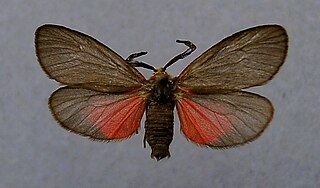
Lepidoptera is an order of insects that includes butterflies and moths. About 180,000 species of the Lepidoptera are described, in 126 families and 46 superfamilies, 10 per cent of the total described species of living organisms. It is one of the most widespread and widely recognizable insect orders in the world. The Lepidoptera show many variations of the basic body structure that have evolved to gain advantages in lifestyle and distribution. Recent estimates suggest the order may have more species than earlier thought, and is among the four most speciose orders, along with the Hymenoptera, Diptera, and Coleoptera.

Moths are a paraphyletic group of insects that includes all members of the order Lepidoptera that are not butterflies, with moths making up the vast majority of the order. There are thought to be approximately 160,000 species of moth, many of which have yet to be described. Most species of moth are nocturnal, but there are also crepuscular and diurnal species.

The Arctiinae are a large and diverse subfamily of moths, with around 11,000 species found all over the world, including 6,000 neotropical species. This group includes the groups commonly known as tiger moths, which usually have bright colours, footmen, which are usually much drabber, lichen moths, and wasp moths. Many species have "hairy" caterpillars that are popularly known as woolly bears or woolly worms. The scientific name of this subfamily refers to this hairiness. Some species within the Arctiinae have the word tussock in their common name due to people misidentifying them as members of the Lymantriinae based on the characteristics of the larvae.

The Zygaenidae moths are a family of Lepidoptera. The majority of zygaenids are tropical, but they are nevertheless quite well represented in temperate regions. Some of the 1000 or so species are commonly known as burnet or forester moths, often qualified by the number of spots, although other families also have 'foresters'. They are also sometimes called smoky moths.

The Tortricidae are a family of moths, commonly known as tortrix moths or leafroller moths, in the order Lepidoptera. This large family has over 10,350 species described, and is the sole member of the superfamily Tortricoidea, although the genus Heliocosma is sometimes placed within this superfamily. Many of these are economically important pests. Olethreutidae is a junior synonym. The typical resting posture is with the wings folded back, producing a rather rounded profile.

The Pyralidae, commonly called pyralid moths, snout moths or grass moths, are a family of Lepidoptera in the ditrysian superfamily Pyraloidea. In many classifications, the grass moths (Crambidae) are included in the Pyralidae as a subfamily, making the combined group one of the largest families in the Lepidoptera. The latest review by Eugene G. Munroe and Maria Alma Solis, in Kristensen (1999) retains the Crambidae as a full family of Pyraloidea.

Parides, commonly called cattlehearts, is a genus of swallowtail butterflies in the family Papilionidae. They are found in the Americas.
Parides burchellanus is a species of swallowtail butterfly. It is endemic to Brazil.
Lamprostola is a genus of moths in the subfamily Arctiinae described by Schaus in 1899.

Aglaope infausta is a moth of the family Zygaenidae.

The Erebidae are a family of moths in the superfamily Noctuoidea. The family is among the largest families of moths by species count and contains a wide variety of well-known macromoth groups. The family includes the underwings (Catocala); litter moths (Herminiinae); tiger, lichen, and wasp moths (Arctiinae); tussock moths (Lymantriinae), including the arctic woolly bear moth ; piercing moths ; micronoctuoid moths (Micronoctuini); snout moths (Hypeninae); and zales, though many of these common names can also refer to moths outside the Erebidae. Some of the erebid moths are called owlets.

Parides eurimedes is a species of butterfly in the family Papilionidae. It is commonly known as the mylotes cattleheart, Arcas cattleheart, pink-checked cattleheart, and true cattleheart. It is native to the Americas.

Parides panthonus, the panthonus cattleheart, is a butterfly of the family Papilionidae. It is found in the Guianas and Suriname.

Parides aglaope is a species of butterfly in the family Papilionidae. It is found in Brazil and Bolivia.

Parides lysander, the Lysander cattleheart, is a species of butterfly in the family Papilionidae. It is found in the Neotropical realm.

Parides tros is a species of butterfly in the family Papilionidae. It is found in the Neotropical realm where it is endemic to Brazil.
Lamprostola aglaope is a moth of the subfamily Arctiinae. It was described by Felder in 1875. It is found in Mexico, Guatemala, Costa Rica and the Amazon region.
Several moth species are known as skeletonizers, including:














